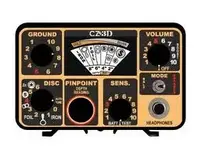Possibly useful. Here's a review I did on the CZ-3D. It's a tad technical but hopefully the main points are interpretable:
As with many other Fisher CZ-3D users, I've been through more detectors than that Carter guy has liver pills. And I'll be the first to admit that there are a slew of very good detectors out there, many at a modest price.
In a book-length volume, I might be able to touch on the highs and lows of detectors from top-shelf models down to those occupying the lower rung. Amazingly, some of the top-dollar machines are all but bottom-dwellers while entry-level models are thoroughly sweet. Which ushers in the Fisher CZ-3D.
I'll generalize this model by saying it's an apex blue-collar machine. It's meant for folks who put in tons of time and aren't afraid to dig for the goods. It is a deep-seeking machine, easily on par with costlier models.
As with all advanced units, it takes some tuning tweaks to come up with the best working relationship twixt detectorist, machine and the environment.
The first step in that direction is developing an ear for the all metals mode, #1 on the CZ-3D “Disc” discrimination knob. Learn the sound IDs therein. Absolutely nix the factory setting at #4. If you exclude up to pull-tabs, you've agreed to ignore some of the most valuable items in the ground.
For high-exploration hunters, detecting iron (FE) items is mandatory when humpin' the boonies for a virgin site. The CZ-3D iron detection (#1) mode, sometimes confusingly referred to as the “relics” mode, will point out the oldest homesteads, even those offering absolutely no surface indicators. CZ-3D is an excellent FE detector.
Once a site is found, a “Disc” knob turn to #2 -- to exclude iron readings -- puts the machine in its top treasure position: non-ferric items.
Once again, it comes down to setting the machine to shine. This is done by slowly moving off the factory settings (red mark at #3) for “Sensitivity.” Go a little past #5. While this increase will also increase false readings, the depth gain is remarkable. To see the change, do an air test on a quarter, going from # 3 to #5. I've found no need to go past #6 on the sensitivity setting.
With higher sensitivity there is that false reading thing, but, with a minimum of practice and ear tuning, it becomes a breeze to sidestep one-pass false beeps. The CZ-3D is tenacious when it comes to grabbing repeatable (good) readings.
Some machines might match the CZ-3D but I've yet to find a single machine that beats it at finding anything from a small button upwards to large cents. And it loves coins and buttons.
Some tips for CZ-3D users:
1) Top headphones are indispensable – with all detectors, by my thinking.
2) Do not get crazy with the “Disc” knob. The higher you go, the more you miss.
3) This machine works best at a slow to moderate head-swing speed. It suffers with fast swings. More than some other machine, this detector needs the head to be angled so it swings perfectly parallel to the ground. This has to be checked frequently. When the head is angled too far upward -- sometime hard to see when swinging it – essentially only a small portion of the loop is passing effectively over the ground. Wasted effort.
4) Volume “Boost” is a bit sophomoric. You get no real sensitivity boost, as implied, but you will hear readings better.
5) Fresh batteries mean everything. I have seen weak batteries miss targets that would have sounded off with fresh batteries – even though companies say that shouldn't happen.
6) Learn to use the “Pinpoint” pushbutton feature when being frustrated by a confusing non-ferric reading. The pushbutton mode is “all metals” and can quickly clarify that a seemingly “good” reading is actually a large iron item.
7) Make certain that the cable from the loop is secured to the lower and center stems. Cable waggle can increase false readings.





